With the iPhone 13 Pro Max, Apple delivers a smartphone with an excellent display, excellent performance and a very good camera. However, all of these properties also apply to the smaller iPhone 13 Pro. The new unique selling point of the iPhone 13 Pro Max is the significantly larger battery, which ensures very good runtimes.
Table of contents
- < li> 1 The marathon runner among smartphones
- Apple ensures parity among the iPhone 13 Pro
- iPhone 13 Pro Max starts at 1,249 euros
- Technical data at a glance
- Half a pound smartphone please
- Perfect workmanship combined with IP68 protection
- Up to 1,000 cd/m in automatic mode
- 2 A15 Bionic with 5-core GPU and battery life
- Apple's two-tier company in the A15
- Apple has by far the fastest chip
- The penta-core GPU is significantly more powerful
- Somewhat better behavior under continuous load
- Apple increases battery by 18.5 percent
- Hardly empty when used intensively
- 3 New triple camera with macro and cinema mode
- Same features for both Pro models
- Smart HDR 4 ensures true-to-original photos
- Clear photos at night
- Ultra wide angle camera weakens at night
- Macro mode is activated automatically
- The best smartphone video camera
- Cinema mode brings bokeh effect to moving images
- ProRes follows with iOS 15.1
- 4 Conclusion
< li> 6.7 inch OLED display with ProMotion
By far the largest smartphone display from Apple is only available this year on the iPhone 13 Pro Max. The colossus measures 6.7 inches and this time also packs a significantly larger battery behind the screen. After the iPhone 13 mini convinced with better runtimes in the test, the iPhone 13 Pro Max succeeds even more clearly – that much can be said in advance in this section.
Apple ensures parity among the iPhone 13 Pro
What the iPhone 13 Pro Max is not this year: the exclusive smartphone with Apple's best camera system. After the manufacturer only donated the best cameras to the iPhone 12 Pro Max (test) last year, thus breaking with the previous approach, parity between the iPhone 13 Pro and iPhone 13 Pro Max now prevails again in this area. Whoever has Apple's best camera system can choose freely between the two smartphones. The iPhone 13 Pro Max is only characterized by the screen and battery size – and the resulting dimensions and weight.
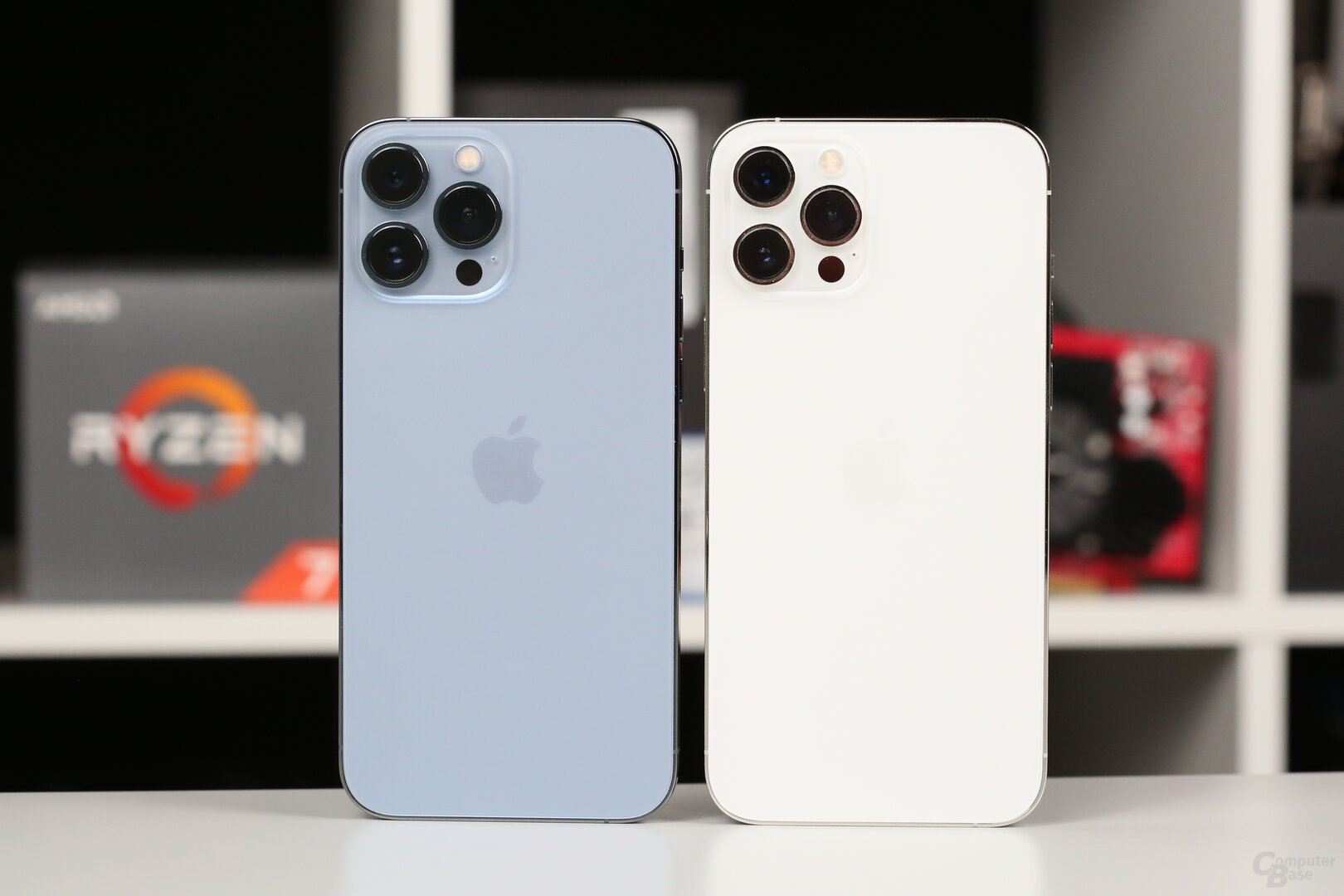 iPhone 13 Pro Max in sierra blue next to iPhone 12 Pro Max in white
iPhone 13 Pro Max in sierra blue next to iPhone 12 Pro Max in white iPhone 13 Pro Max starts at 1,249 euros
The entire new iPhone 13 family has been available in Germany since September 24th, after being pre-ordered since September 17th. The iPhone 13 Pro Max is available in the colors graphite, gold, silver and sierra blue (test device) and starts with 128 GB of storage at 1,249 euros. The smartphone costs € 1,369 with 256 GB and € 1,599 with 512 GB. For the first time, Apple is also offering a version with 1 TB storage for 1,829 euros.
Technical data at a glance
Apple iPhone 13 Pro Max Apple iPhone 6Apple iPhone 6 PlusApple iPhone 6sApple iPhone 6s PlusApple iPhone 7Apple iPhone 7 PlusApple iPhone 8Apple iPhone 8 PlusApple iPhone 11Apple iPhone 11 ProApple iPhone 11 Pro MaxApple iPhone 12Apple iPhone 12 miniApple iPhone 12 Pro Max ✔Apple iPhone 12 ProApple iPhone 8 Plus 13Apple iPhone 13 miniApple iPhone 13 ProApple iPhone 13 Pro Max ✔Apple iPhone SE (2020) Apple iPhone XApple iPhone XrApple iPhone XsApple iPhone Xs Max Apple iPhone 12 Pro Max Apple iPhone 6Apple iPhone 6 PlusApple iPhone 6sApple iPhone 6s PlusApple iPhone 7Apple iPhone 7 PlusApple iPhone 8Apple iPhone 8 PlusApple iPhone 11Apple iPhone 11 ProApple iPhone 11 Pro MaxApple iPhone 12Apple iPhone 12 miniApple iPhone 12 Pro Max ✔Apple iPhone 12 ProApple iPhone 13Apple iPhone 13 miniApple iPhone 13 ProApple iPhone 13 Pro Max ✔Apple iPhone SE (2020) Apple iPhone XApple iPhone XrApple iPhone XsApple iPhone Xs Max software:
(when released) iOS 15 iOS 14 display: 6.70 inches, 1,284 × 2,778
4 57 ppi, 120 Hz
OLED, HDR, Ceramic Shield 6.70 inches, 1,284 × 2,778
457 ppi, 60 Hz
OLED, HDR, Ceramic Shield Operation: Touch, face scanner SoC: Apple A15 Bionic < br> 2 × Avalanche, 3.20 GHz
4 × Blizzard, 2.00 GHz
5 nm, 64-bit Apple A14 Bionic
2 × Firestorm, 3.00 GHz
4 × Icestorm, 1.82 GHz or 5 nm, 64-bit GPU: Apple Penta-Core Apple Quad-Core RAM: 6,144 MB
LPDDR4X memory: 128/256/512/1,024 GB 128/256/512 GB 1st camera: 12.0 MP, 2160p
Quad-LED, f/1.5, AF, OIS 12.0 MP, 2160p
Quad-LED , f/1.6, AF, OIS 2nd camera: 12.0 MP, f/1.8, AF 12.0 MP, f/2.4 3rd camera: 12.0 MP, f/2.8 , AF, OIS 12.0 MP, f/2.2, AF, OIS 4th camera: No 5th camera: No 1st front camera: 12.0 MP, 2160p
Display flash, f/2.2 2nd front camera: No GSM: GPRS + EDGE UMTS: DC-HSPA
↓ 42.2 ↑ 5.76 Mbit/s LTE: Advanced Pro Advanced Pro
↓ 2,000 5G : NSA/SA WLAN: 802.11 a/b/g/n/ac/ax Bluetooth: 5.0 Location: A-GPS, GLONASS, BeiDou, Galileo, QZSS Other standards: Lightning, UWB, NFC SIM card: Nano-SIM, Dual SIM battery: 4,352 mAh (16.75 Wh)
permanently installed, wireless charging 3,687 mAh (14.13 Wh), 20.0 W
Permanently installed, wireless charging Size (W × H × D): 78.1 × 160.8 × 7.65 mm 78.1 × 160.8 × 7.40 mm Protection class: IP68 Weight: 238 g 226 g Price: from € 1,217/from € 1,322/from € 1,552/from € 1,782 from € 1,099/from € 1,175/from € 1,351
Half a pound smartphone please
The iPhone 13 Pro Max lives up to its name, especially considering the addition of “Max”. This smartphone wants to be tamed with 78.1 × 160.8 × 7.65 mm (W × H × D), not even mentioned of the 238 g weight. In any case, you carry more than half a pound of smartphone with you, including the case. Apple included a Clear Case with MagSafe with the test device, which brings the weight to 274 g. That's another 12 g more than the iPhone 12 Pro Max.
Cases help with handling
Speaking of cases: Depending on their nature, they are well suited to give the iPhone 13 Pro Max more grip. The smartphone is of course nicer to touch without a second skin, because Apple once again ensures a very high-quality look and feel with polished stainless steel and matt glass. The smartphone is not particularly secure in the hand without additional protection, so a silicone or leather cover is helpful in this regard.
-
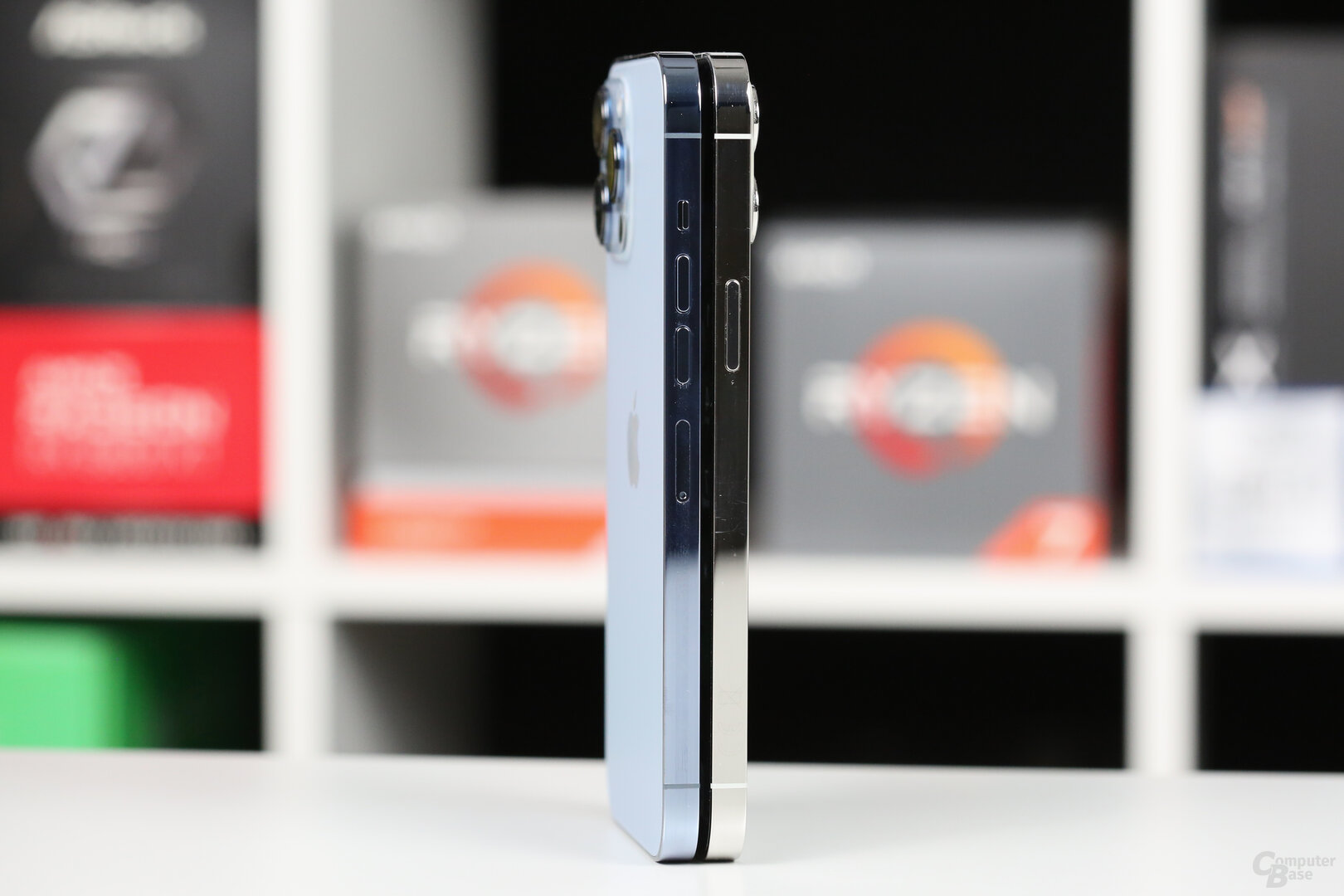 Only the Pro smartphones have the polished stainless steel frame
Only the Pro smartphones have the polished stainless steel frame
Image 1 of 4
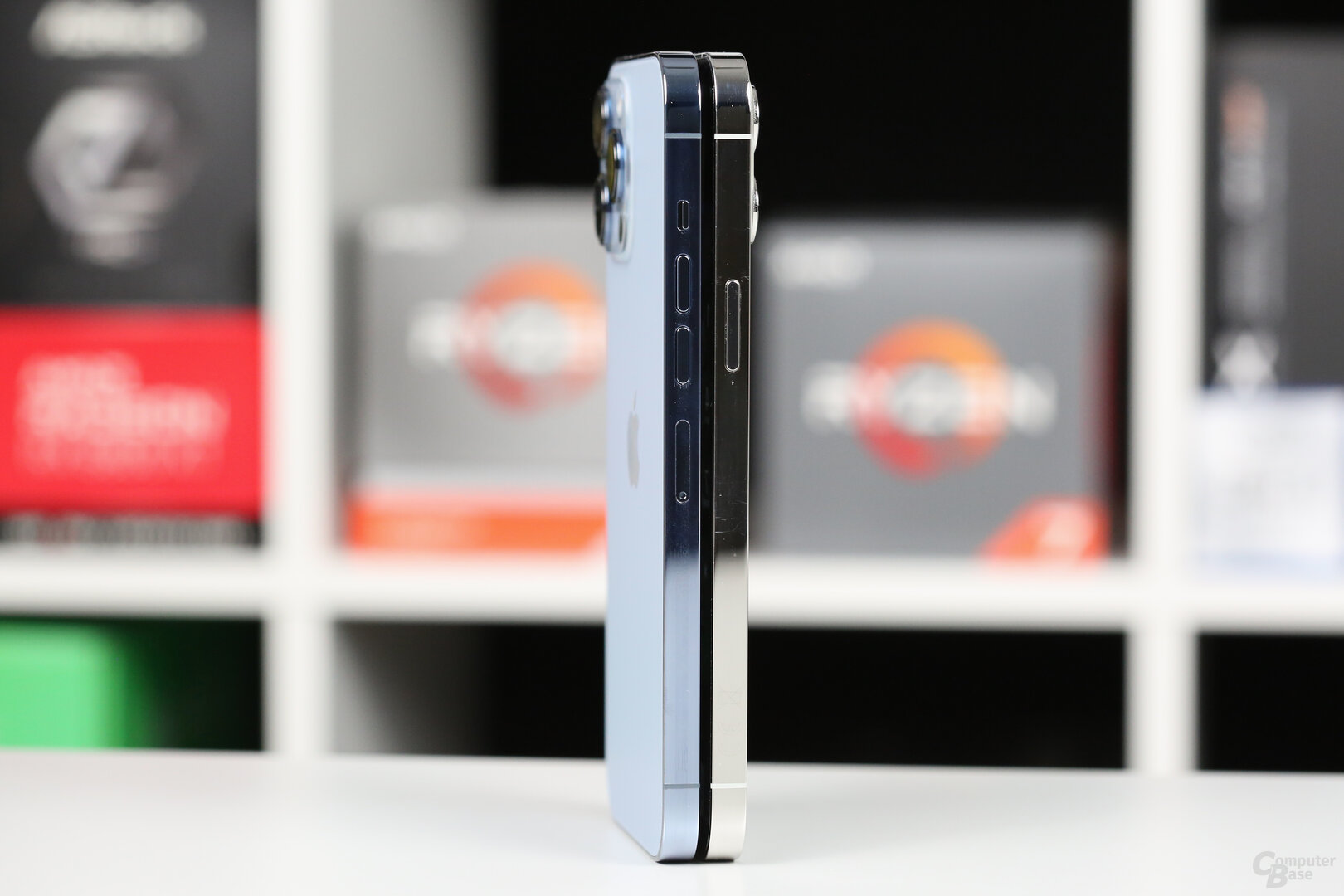 Only the Pro smartphones have the polished stainless steel frame
Only the Pro smartphones have the polished stainless steel frame  Sierra blue vs. Pacific blue
Sierra blue vs. Pacific blue 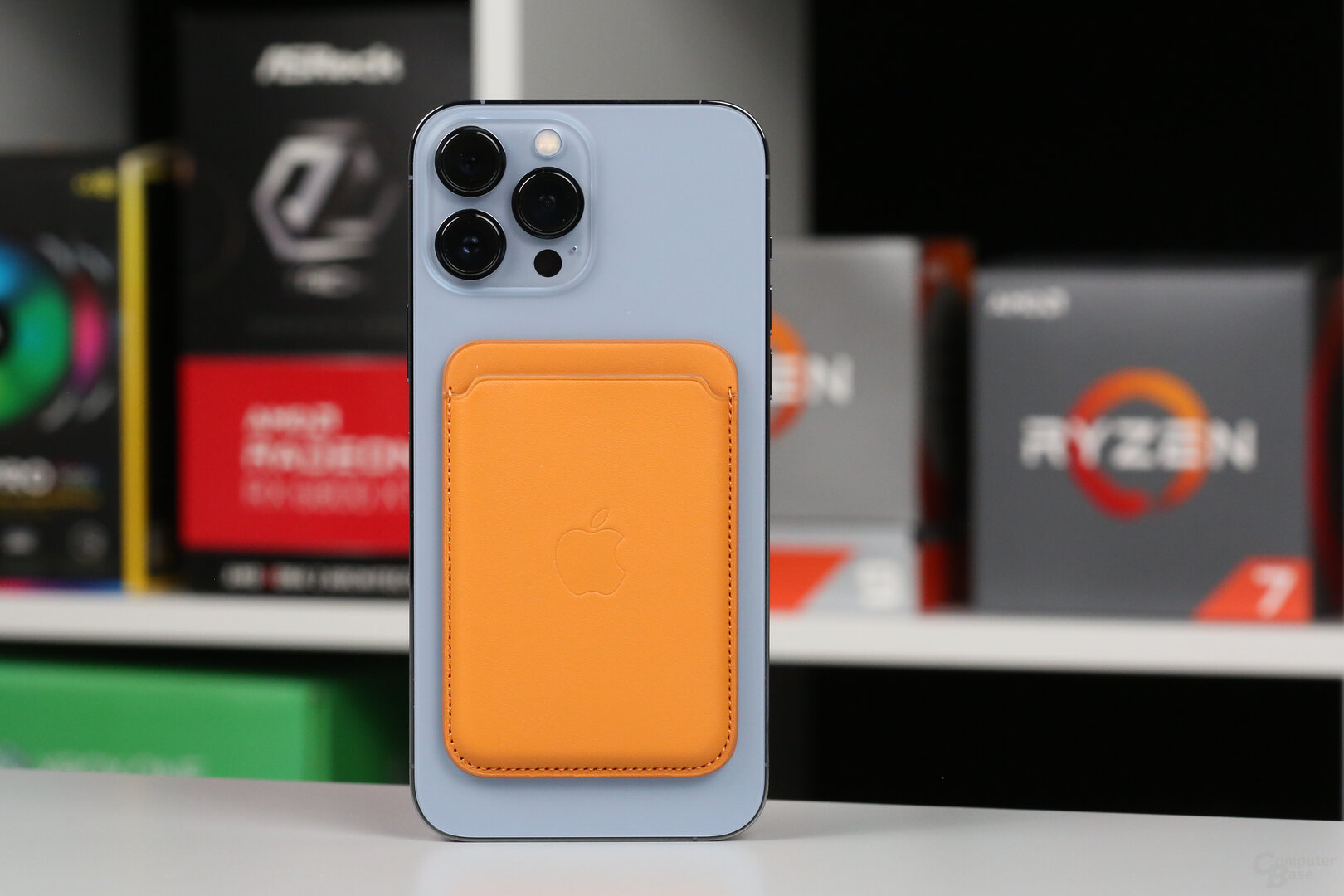 iPhone 13 Pro Max with MagSafe Wallet in golden brown
iPhone 13 Pro Max with MagSafe Wallet in golden brown The Clear Case from Apple, on the other hand, does not help in any way from this point of view, especially since this year the fit and finish are again far removed from the price of 55 euros. The case of the test device shows way too much play after the case of an iPhone 12 Pro was too tight last year and already showed cracks in the lower area around the recess after the first time it was put on.
Perfect workmanship combined with IP68 protection
Apple delivers the smartphone itself, however, with perfect workmanship. Keys, sockets, SIM tray, speakers and cameras are all areas in which the accuracy of fit is at an excellent level. Again, an IP68 certification protects against the ingress of dust and water, which allows submersion in water up to 6 m deep for 30 minutes. The display is protected by Ceramic Shield, as Apple has called the glass since the iPhone 12 – you shouldn't drop the smartphone despite its supposedly robust properties.
6.7 inch OLED display with ProMotion
Like last year, Ceramic Shield protects a 6.7-inch OLED display with a resolution of 1,284 × 2,778 pixels. This year there are innovations in three areas: a 20 percent smaller Face ID system, ProMotion and maximum brightness. ProMotion stands for a variable refresh rate from 10 to 120 Hz. The technology known for years from the iPad Pro is moving to Apple's Pro after a long wait and the expectation that ProMotion should have been introduced with the iPhone 12 Pro last year at the latest -Smartphones on.
- < li>
 6.7 inch OLED display
6.7 inch OLED display Image 1 of 5
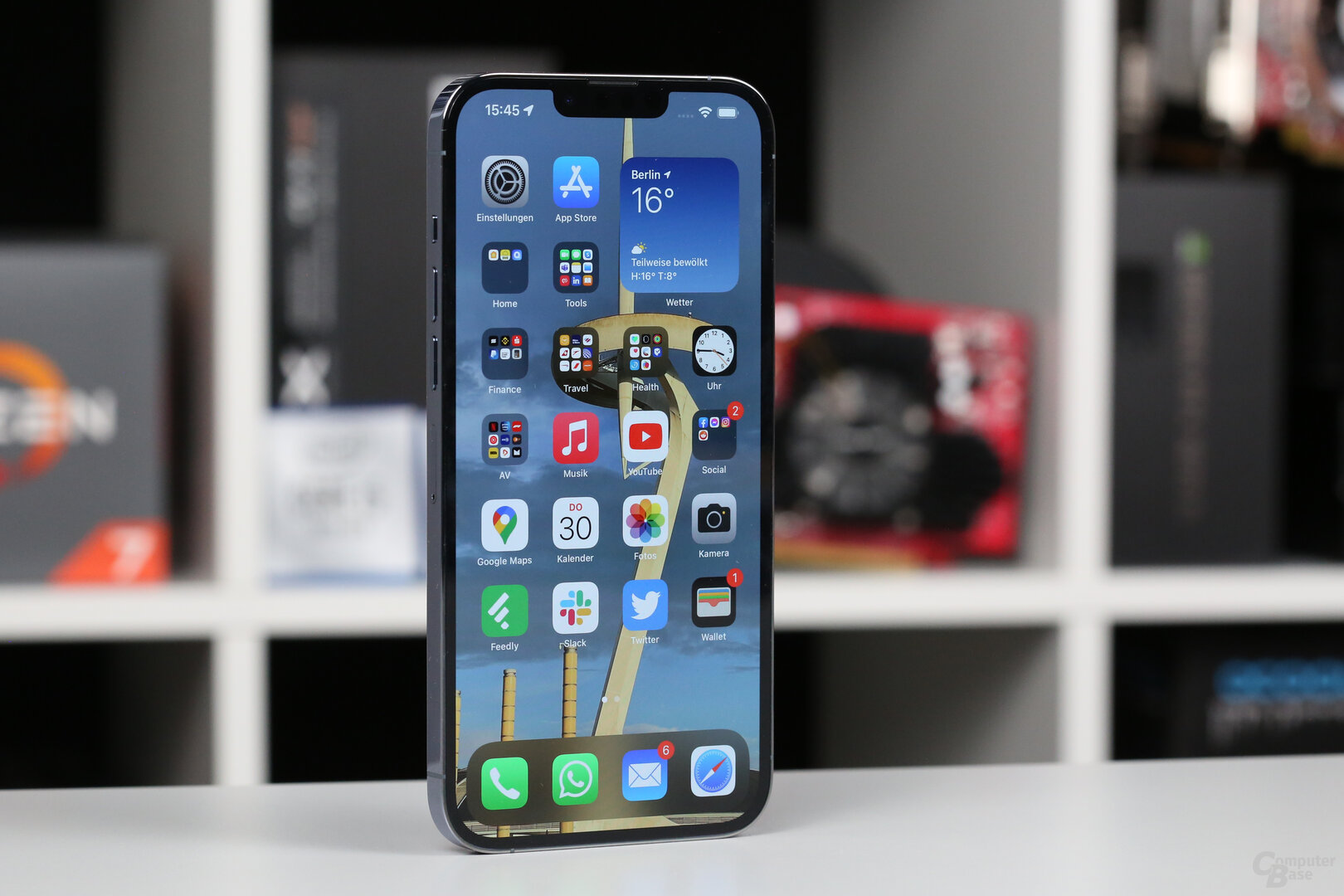 6.7 inches large OLED display
6.7 inches large OLED display 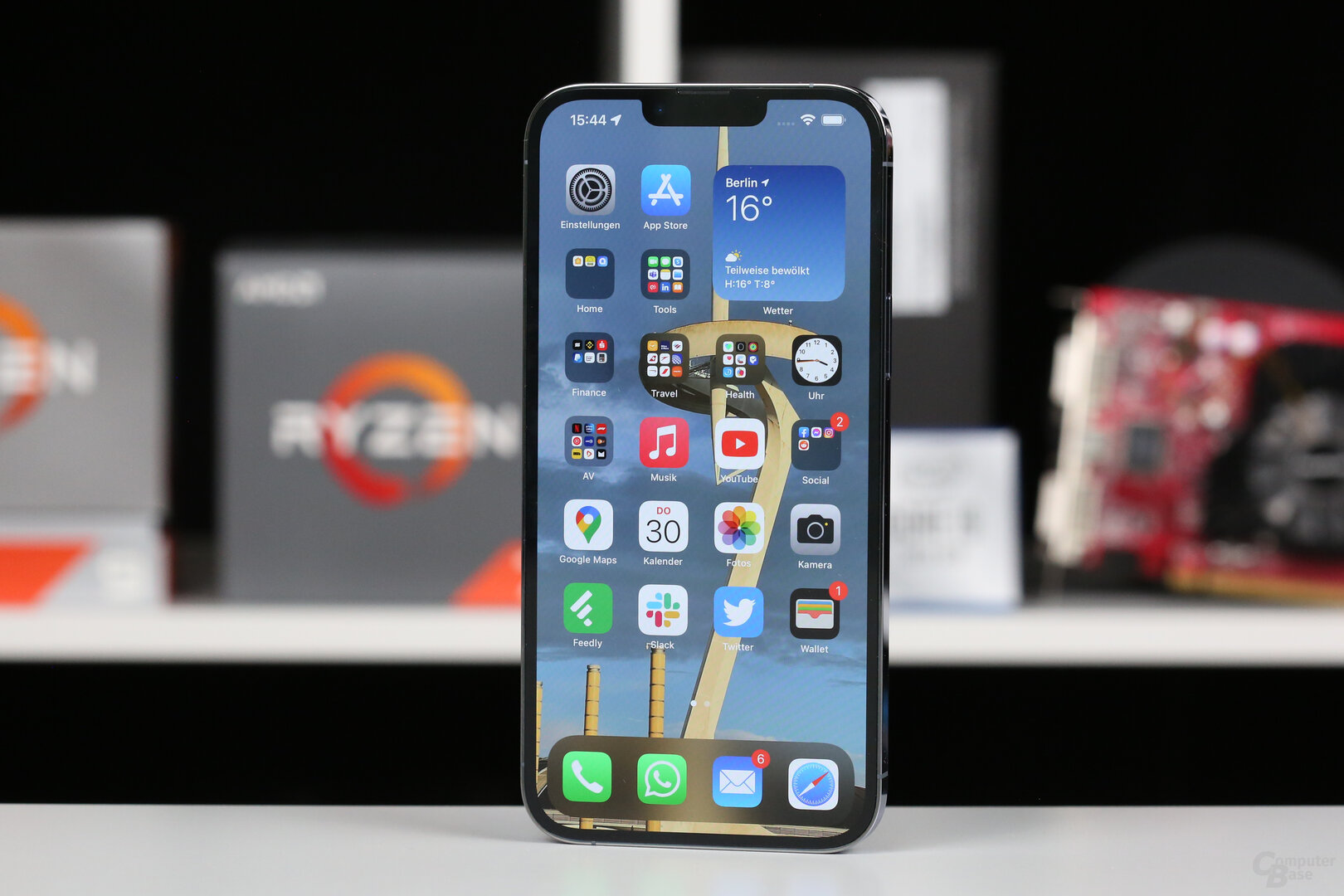 The resolution is again 1,284 × 2,778 pixels
The resolution is again 1,284 × 2,778 pixels 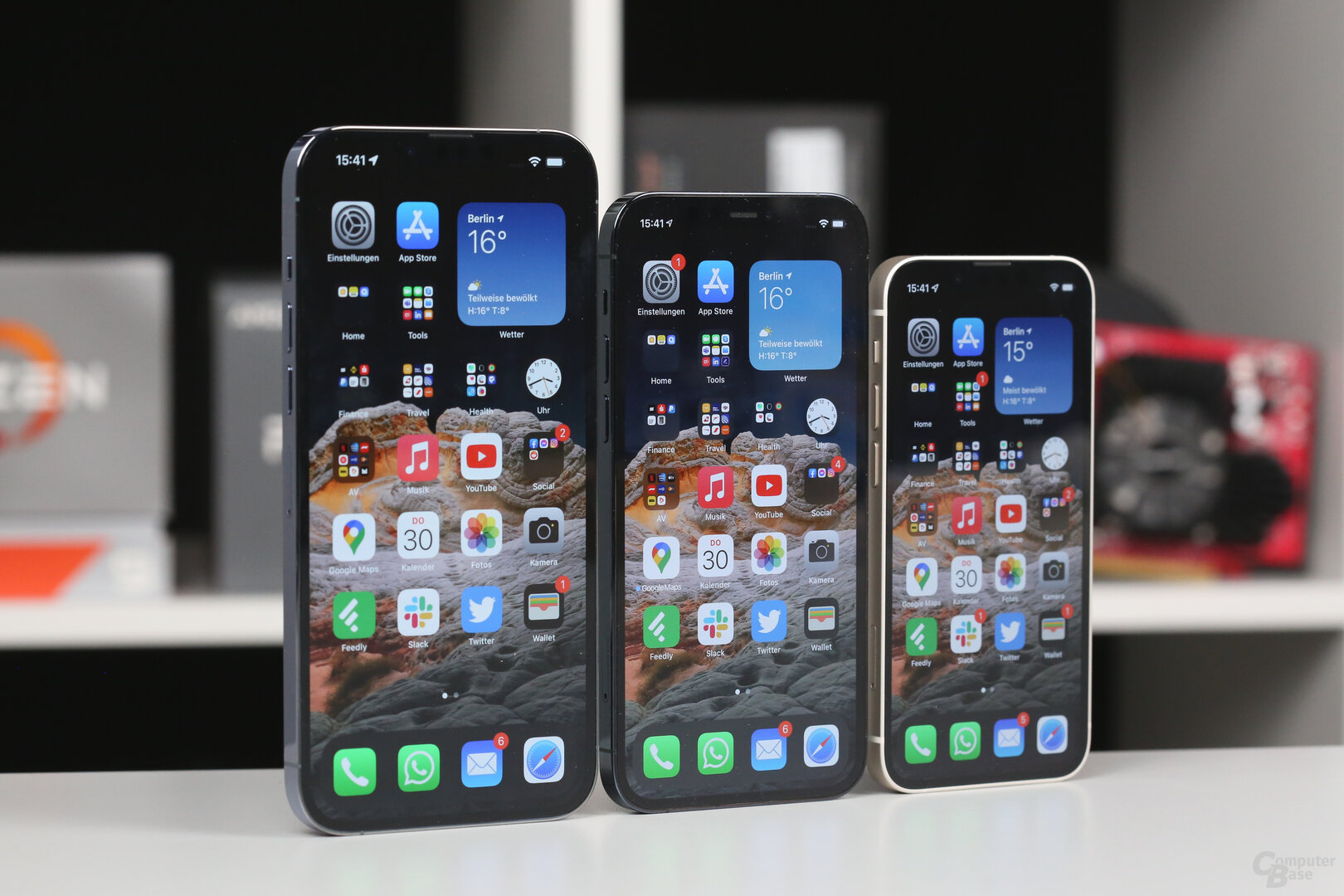 6.7 inches, 6.1 inches and 5.4 inches in comparison
6.7 inches, 6.1 inches and 5.4 inches in comparison 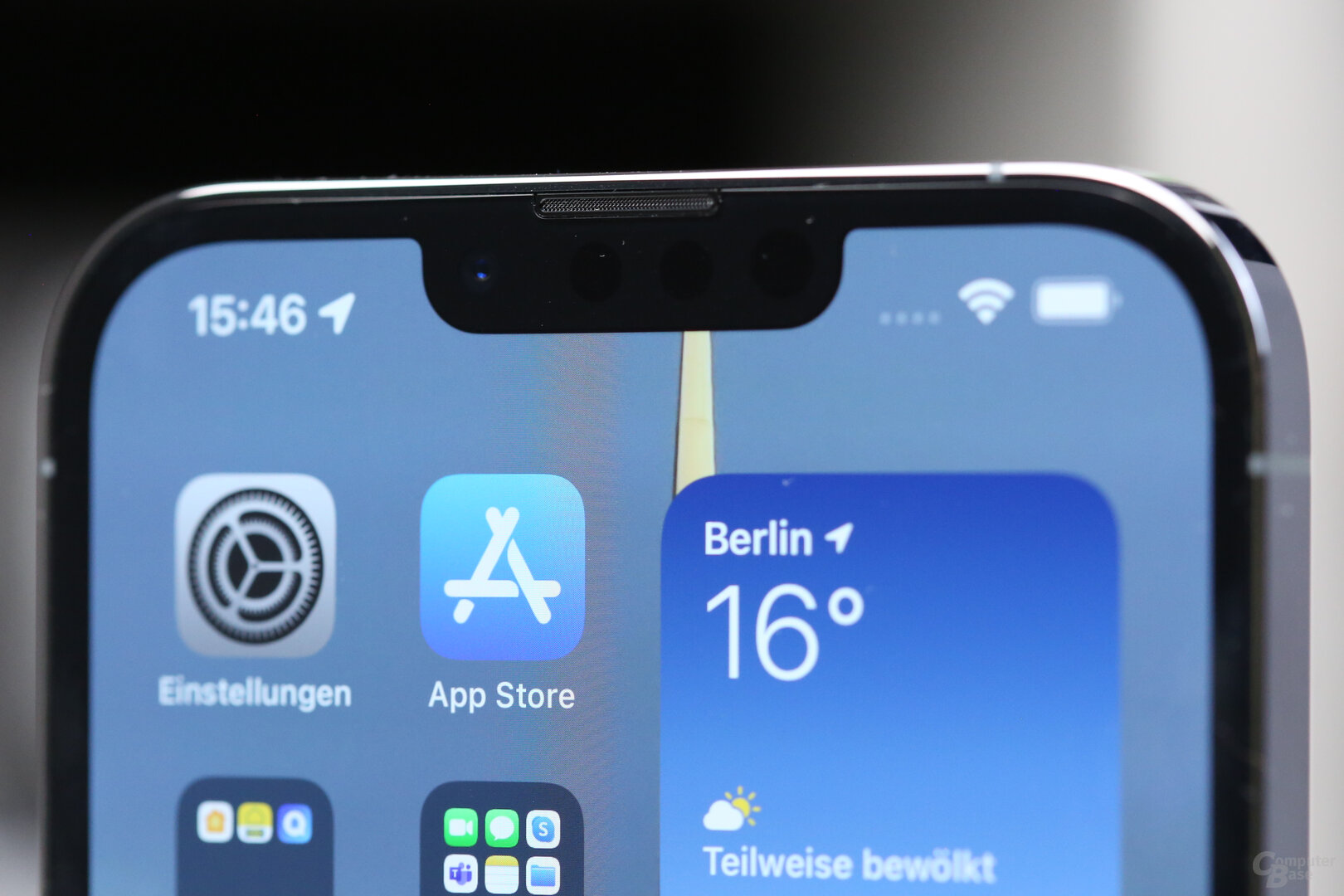 20 percent smaller notch compared to the iPhone 12 series
20 percent smaller notch compared to the iPhone 12 series The variable refresh rate means that it can adapt to the respective content, so that a video with 30 FPS runs at 30 Hz, a film with 24 FPS but only with 24 Hz and games with 120 Hz. Up to 120 Hz is also possible during normal operation of the smartphone on the home screen or in the Control Center, in the settings or in the notifications. As Apple explains, the refresh rate is adapted to the speed of operation by the user, so that fast swiping and scrolling drive the frequency up.
No iPhone has ever been this smooth
But do you really notice the difference right away? The iPhone cannot be operated any faster, but it is much more fluid. In contrast to Android, iOS has never been the operating system that stood out with lightning-fast transitions due to the slightly slower animations. But it has always been very “smooth” when you can describe the smooth changes between the individual levels in this way. And it is precisely this visual impression that ProMotion clearly reinforces again, with some haptic effects as well, because the maximum doubled frequency allows interaction with the content to be more direct.
ProMotion can save the battery
ProMotion not only has an impact on the perceived performance of the smartphone, but can also contribute to improved efficiency. Because where previously static 60 Hz were used, although they were not needed, it can now be reduced to 30 Hz, 25 Hz or even to just 10 Hz when reading without moving the content. In the battery test, for example, which is carried out on the basis of a 24 FPS video, the iPhone with ProMotion even performs slightly better than without it. More about this on the next page.
One more point should be mentioned with ProMotion: The technology is activated ex works, but ultimately purely optional and can be deactivated at any time, as on the iPad Pro. Apple hides the corresponding setting under “Settings → Accessibility → Movement → Limit frame rate”. In this mode and when the energy-saving mode is activated, the maximum frame rate is reduced to 60 Hz.
Up to 1,000 cd/m in automatic mode
The new OLED display also brings improvements in terms of brightness. On this point, Apple advertises up to 1,000 cd/m² in SDR mode, while the maximum for HDR is 1,200 cd/m², as last year. This corresponds to an increase of 25 percent compared to the previous year, when 800 cd/m² was advertised. Apple calls this value for the iPhone 13 (mini), whose predecessor still had to get by with 625 cd/m².
-
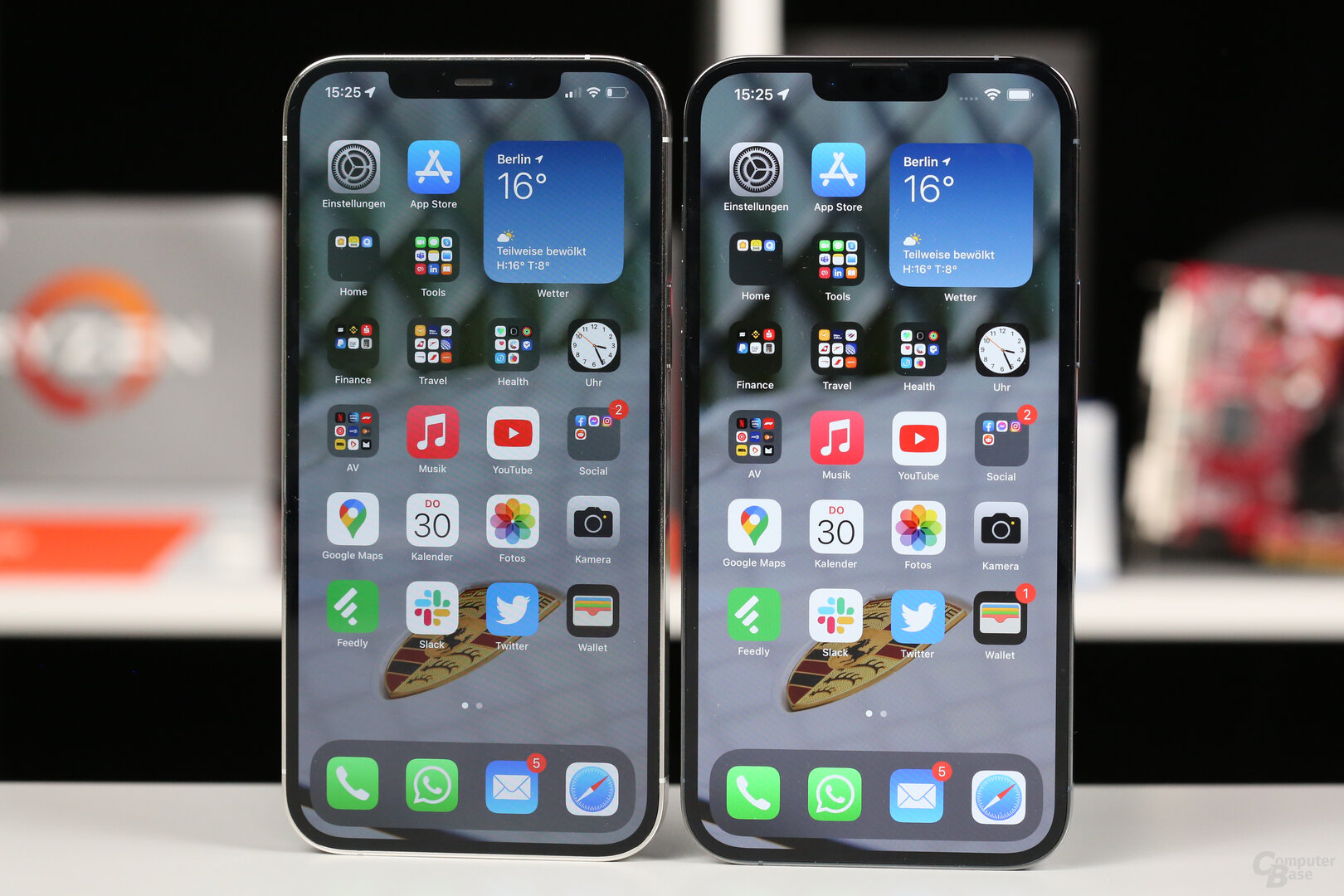 ProMotion on the iPhone 13 Pro Max (r.) can only be felt when using
ProMotion on the iPhone 13 Pro Max (r.) can only be felt when using
Image 1 of 3
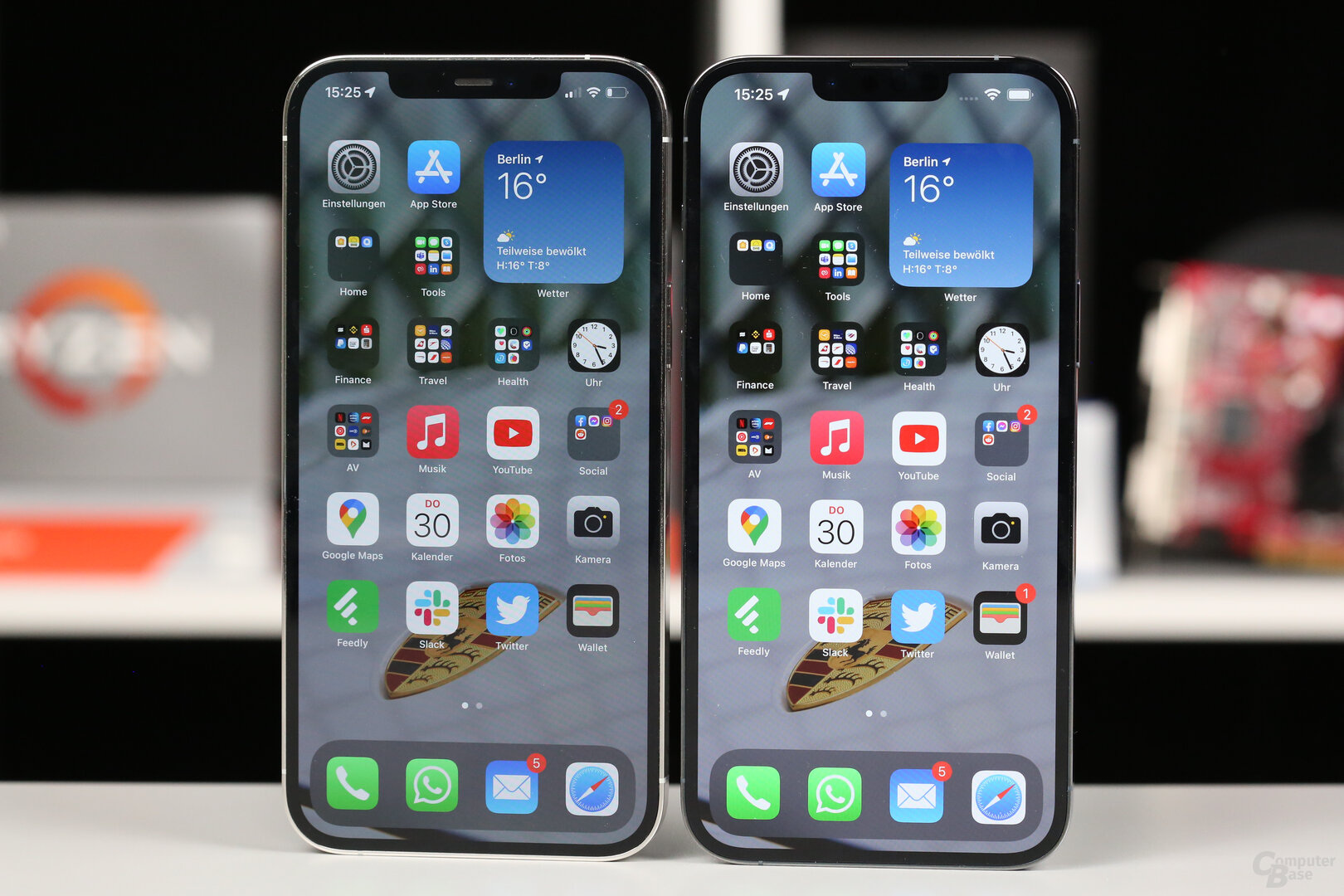 ProMotion on the iPhone 13 Pro Max (r .) can only be felt when using
ProMotion on the iPhone 13 Pro Max (r .) can only be felt when using  The perfect black values are typical for OLED
The perfect black values are typical for OLED  Very good image quality like the last few years
Very good image quality like the last few years How Apple achieves the new maximum brightness, however, is different for the first time since the switch to OLED with the iPhone X. Because it is no longer the user himself who can call up the maximum value, but only the automatic brightness regulation depending on the ambient light, which is determined by a brightness sensor in the notch. If you control the brightness of the panel manually via the Control Center, you will achieve brightness values of around 800 cd/m², as in the previous year. Armed with a bright LED headlight and aimed at the sensor, the editorial team was then able to measure the value advertised by Apple at 1,056 cd/m² in automatic mode.
«Previous display brightness max. Display brightness min. Display- Contrast Next »
- 66 entries display brightness max. unit: luminance (cd/m²)
- Automatic mode 100% APL:
- Apple iPhone 13 Pro1.063White point: approx. 6,800
- Apple iPhone 13 Pro Max (automatic) 1,056 white point: approx. 6,300
- Samsung Galaxy S21 Ultra973 white point: approx. 6,700
- Samsung Galaxy Z Flip 3894 white point: approx. 6,600
- Xiaomi Mi 11 Ultra878 white point: approx. 7,100
- Apple iPhone 13 mini858 white point: approx. 6,200
- Apple iPhone 12 Pro Max854White point: approx. 6,300
- Apple iPhone 13 Pro Max (manual) 853 white point: approx. 6,300
- Apple iPhone 12 Pro842 white point: approx. 6,300
- Apple iPhone 11 Pro Max797 white point: approx. 6,900
- OnePlus 9 Pro787 white point: approx. 6,800
- Xiaomi Mi 11783 white point: approx. 6,900
- Samsung Galaxy A52 5G772 white point: approx. 6,800
- Qualcomm Smartphone for Snapdragon Insiders765 white point: approx. 7,200
- Samsung Galaxy S20 Ultra762 white point: approx. 7,200
- Oppo Find X3 Pro745 white point: approx. 7,200
- Google Pixel 5687 white point: approx. 6,500
- Cat S61672 white point: approx. 7,400
- Google Pixel 4a 5G655 white point: approx. 6,600
- Apple iPhone Xs Max644 white point: approx. 6,900
- OnePlus Nord 2610 white point: approx. 7,100
- Nokia XR20592 white point: approx. 8,150
- Sony Xperia 5 III563 white point: approx. 7,200
- LG G7 ThinQ546 white point: approx. 9,300
- Sony Xperia 5 II536White point: approx. 7,500
- Samsung Galaxy A50515 white point: approx. 7,100
- Vivo X60 Pro503 white point: approx. 7,600
- Google Pixel 3a406White point: approx. 6,900
- Automatic mode 100% APL:
- 65 entries display brightness min. unit: luminance (cd/m²)
-
- Apple iPhone Xs Max2
- Apple iPhone 11 Pro Max2
- Samsung Galaxy S20 Ultra2
- Google Pixel 52
- Google Pixel 4a 5G2
- Apple iPhone 12 Pro2
- Apple iPhone 12 Pro Max2
- Samsung Galaxy S21 Ultra2
- Xiaomi Mi 112
- OnePlus 9 Pro2
- Samsung Galaxy A52 5G2
- Xiaomi Mi 11 Ultra2
- Vivo X60 Pro2
- OnePlus Nord 22
- Samsung Galaxy Z Flip 32
- Apple iPhone 13 Pro2
- Apple iPhone 13 mini2
- Apple iPhone 13 Pro Max (automatic) 2
- Oppo Find X3 Pro3
- Nokia XR203
- Sony Xperia 5 III4
- Qualcomm Smartphone for Snapdragon Insiders5
-
- 66 entries Display contrast Unit: Contrast
-
- Samsung Galaxy A65.000: 1OLED display
- Apple iPhone Xs Max5.000: 1OLED- Display
< li class = "chart__row chart__row - hidden toggle-body-item nojs-tr"> Huawei P30 Pro5.000: 1OLED display
- Apple iPhone 11 Pro Max5.000: 1OLED display
- Samsung Galaxy S20 Ultra5.000: 1OLED display
- Google Pixel 4a5.000: 1OLED display
- Google Pixel 55,000: 1OLED display
- Google Pixel 4a 5G5.000: 1OLED display
- Apple iPhone 12 Pro5,000: 1OLED display
- Apple iPhone 12 Pro Max5,000: 1OLED display
- Samsung Galaxy S21 Ultra5,000: 1OLED display
- Xiaomi Mi 115,000: 1OLED display
- OnePlus 9 Pro5.000: 1OLED display
- Oppo Find X3 Pro5.000: 1OLED display
- Samsung Galaxy A52 5G5.000: 1OLED display
- Xiaomi Mi 11 Ultra5.000: 1OLED display
- Vivo X60 Pro5.000: 1OLED display
- OnePlus Nord 25,000: 1OLED display
- Qualcomm Smartphone for Snapdragon Insiders5,000: 1OLED display
- Samsung Galaxy Z Flip 35,000: 1OLED -Display
- Sony Xperia 5 III5.000: 1OLED display
- Apple iPhone 13 Pro5.000: 1OLED display
- Apple iPhone 13 mini5,000: 1OLED display
- Apple iPhone 13 Pro Max (automatic) 5,000: 1OLED display
- Nokia XR201 .518: 1
- Motorola One Vision1.045: 1
-
Brightness still not dependent on the APL
What Apple, on the other hand, has not changed is the waiver of coupling the brightness to the “Average Picture Level” (APL), that is, the proportion of white displayed on the panel. The iPhone 13 Pro Max doesn't care whether only 20 percent of the screen is a white rectangle or the entire panel is required with a white surface – in both situations over 1,000 cd/m² can be achieved. Together with the smaller iPhone 13 Pro, Apple offers the currently brightest OLED screen of all tested smartphones with an APL of 100 percent.
Samsung retains advantage with peak brightness
Samsung, on the other hand, couples the brightness to the APL and thus has an advantage with the Galaxy S21 Ultra (test). Because with 100 percent APL the smartphone is only slightly behind the current iPhone with 973 cd/m², but with a reduced APL more than 1,400 cd/m² are possible. Selective highlights, for example in HDR mode, come into their own a little better with Samsung. On the whole, however, both manufacturers currently deliver the best OLED screens for smartphones. As always, Apple scores with the most realistic image possible, with colors and contrast being a touch more intense this year. It will be exciting what Google will deliver with the Pixel 6 and Pixel 6 Pro (hands-on) in this area, because Apple and Samsung set the bar extremely high.
The same Incidentally, this applies to the processor, which Apple only has in the Pro models with the A15 Bionic in the more powerful Penta-Core GPU configuration, which is dealt with on the next page.
On the next page: A15 Bionic with 5-core GPU and battery life